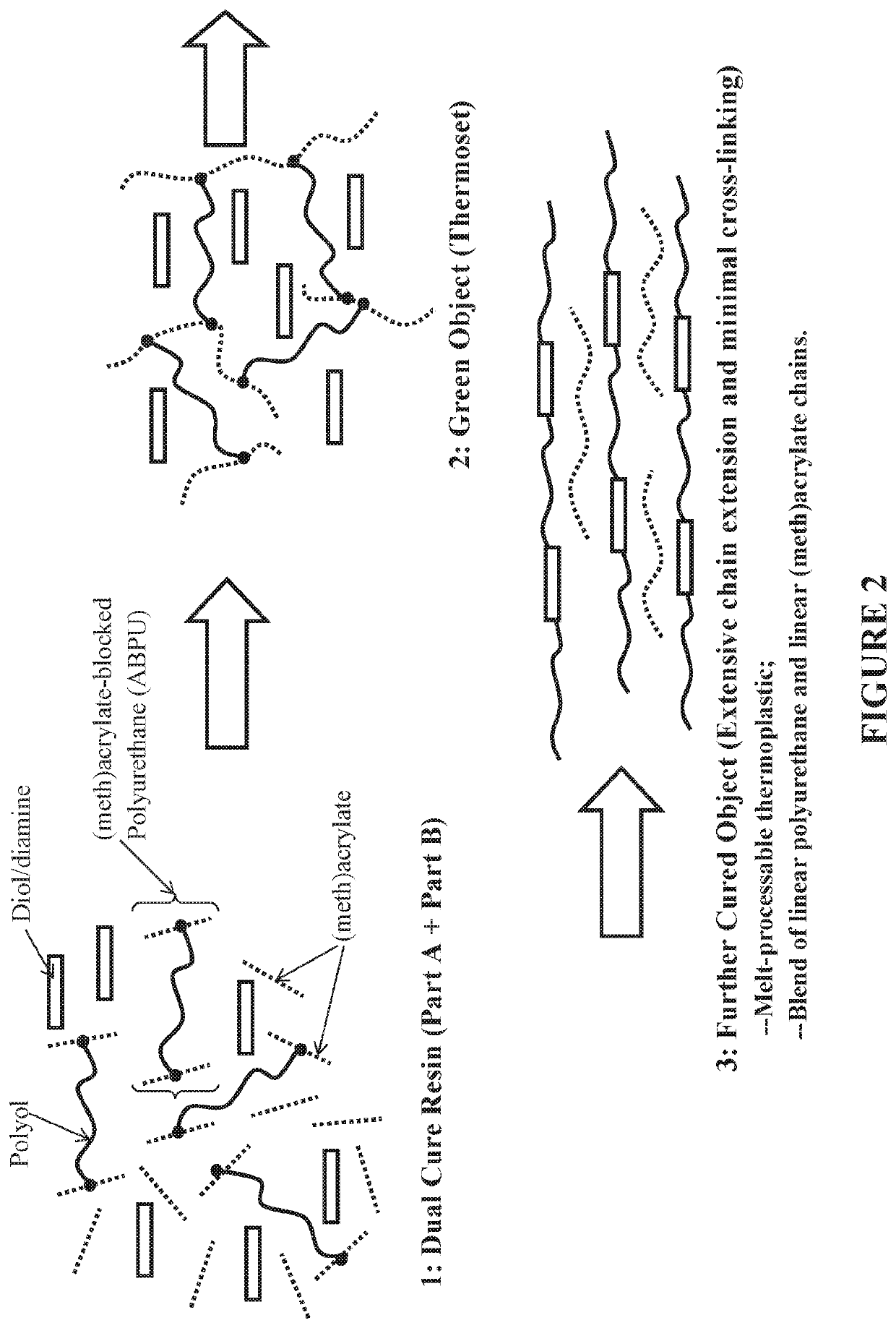Sustainable additive manufacturing resins and methods of recycling
- Summary
- Abstract
- Description
- Claims
- Application Information
AI Technical Summary
Benefits of technology
Problems solved by technology
Method used
Image
Examples
example 1
Preparation of (Meth)Acrylate Blocked Polyurethanes (ABPUs)
[0074]ABPUs as described herein are prepared in substantially the same manner as described in Rolland et al., U.S. Pat. No. 9,453,142 (see, e.g., Column 40 lines 25-52 and Examples 15-16) from TBAEMA, HMDI, and PO3G2k (for ABPU-A), PO3G1k (for ABPU-B), PTMO2k (for ABPU-C), or PTMO650 (for ABPU-D), in the following molar ratios:[0075]ABPU-A: 2.4:2.2:1.0 TBAEMA:HMDI:PO3G2k[0076]ABPU-B: 2.4:2.2:1.0 TBAEMA:IMDI:PO3G1k[0077]ABPU-C: 2.4:2.2:1.0 TBAEMA:HMDI:PTMO2k[0078]ABPU-D: 2.4:2.2:1.0 TBAEMA:HMDI:PTMO650
example 2
Preparation of a Recyclable, Elastomeric Polyurethane, Dual Cure Resin
[0079]All components of Table 1, including MACM, were mixed at 2000 rpm for 30 minutes or until the photoinitiator was completely dissolved.
TABLE 1Elastomeric Dual Cure ResinComponentMass (g)ABPU-A23.49ABPU-B38.04DINA (Non-reactive diluent)19.89MACM (diamine chain extender)7.32TPO (photoinitiator)0.59Magenta pigment0.126
example 3
Preparation of a Recyclable, Flexible Polyurethane, Dual Cure Resin
[0080]All components of Table 2, excluding MACM, were mixed at 2000 rpm for 30 minutes or until the solids were completely dissolved. The MACM was then added and allowed to mix in a THINKY® blender for four minutes and defoam for thirty seconds.
TABLE 2Flexible Dual Cure ResinComponentMass (g)ABPU-C52.17ABPU-D8.71IBOMA (reactive diluent)31.41TPO (photoinitiator)0.99MACM (chain extender)6.42Tinuvin 765 (1 wt %)1.02Tinuvin 400 (0.7 wt %)0.7143Tinuvin 479 (0.3 wt %)0.3061Tinuvin 477 (0.4 wt %)0.4070Cyan Pigment0.0266
PUM
| Property | Measurement | Unit |
|---|---|---|
| Percent by mass | aaaaa | aaaaa |
| Fraction | aaaaa | aaaaa |
| Fraction | aaaaa | aaaaa |
Abstract
Description
Claims
Application Information
 Login to View More
Login to View More - R&D Engineer
- R&D Manager
- IP Professional
- Industry Leading Data Capabilities
- Powerful AI technology
- Patent DNA Extraction
Browse by: Latest US Patents, China's latest patents, Technical Efficacy Thesaurus, Application Domain, Technology Topic, Popular Technical Reports.
© 2024 PatSnap. All rights reserved.Legal|Privacy policy|Modern Slavery Act Transparency Statement|Sitemap|About US| Contact US: help@patsnap.com









